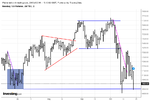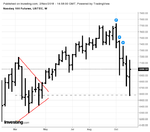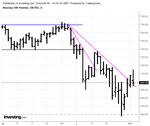I wouldn't say that "this is what the whole SLA/AMT is has been about". Someone who knows nothing about either would look at your chart and snort that it's all hindsight. Which, technically, is true. However, those who have gone to the trouble of investigating the basics of either the SLA or AMT or both would know that the "whole thing" begins with deciding just what it is one wants, specifically (a) in what timeframe one wants to trade and (b) what interval he's going to use to trade it. For example, if one is interested in a months-long timeframe, he is most likely going to trade within that using a weekly or daily interval. If he is rather interested in weeks, he may use a daily or an hourly interval. Daytrading is not an option for the typical inexperienced trader.
Once he's decided on what timeframe he's interested in and the interval he's going to use to trade it, he then has to learn what a climax is and what a test is and how to recognize these in real time. If he understands what a climax and test are but can't recognize them in real time, then he will spend his time dwelling on all those trades he should have taken instead of profiting from what he ought to have learned by then.
And this is where beginners stumble. They don't know, for example, what a climax is so they don't know how to recognize it, even in hindsight. And since they don't know how to recognize it, they don't know how to act on it. And since they don't know how to act on it, they compensate by drawing a bunch of lines (those who understand what the lines are and what they're for benefit from them, as you have done; those who don't understand any of this just wind up lost).
The reversal occurred on the 1st and 2nd. The retracement peaked on the 16th and 17th. If one acted on any of that, there is nothing left for him to do until price reaches a selling climax. He can track the balance between supply and demand as Gringo has done, but he doesn't have to. Imbalances between supply and demand are in and of themselves insufficient triggers. The trigger is the willingness of important money to stop and reverse the decline, and so far there has been only slight evidence of that willingness (e.g., the 11th).
Db




